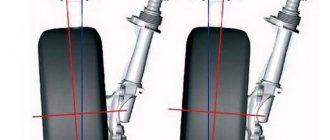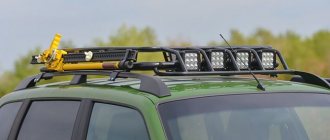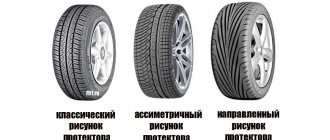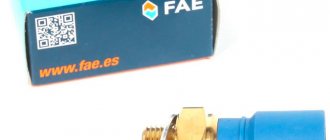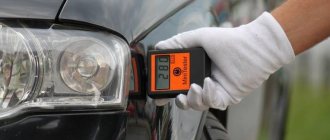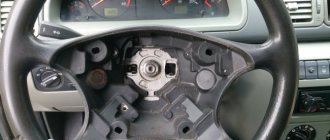What is "alignment"
The wheels of the car must be located at a certain angle relative to the horizontal plane (cam), the same applies to the vertical plane (toe). This is necessary for better tire grip and an acceptable driving experience.
Proper adjustment of caster and toe angles ensures stable handling and vehicle stability.
Convergence
This value can be either "plus" (when imaginary lines running parallel to the drive wheels have an intersection point in front of the vehicle's "nose") or "minus" (if the intersection point is at the rear). It should be understood that the closer the toe angle is to zero, the lower the vehicle's resistance to the rolling effect.
A negative toe angle is bad. In this case, there will be poor handling and poor response when turning the steering wheel. For everything else, it will make the car yawn while traveling (especially at high speeds). The risk of uncontrolled skidding increases significantly.
If there is a strong discrepancy between the approach angles and the factory settings, an increase in tire wear is observed:
- If positive. on its outer part;
- The negative ones. internal surfaces.
Therefore, experimenting with this angle is not recommended.
Collapse
Bend. this is the angle between the imaginary vertical plane and the lateral plane of the wheel. If the top of the wheels “looks” at the center of the car, the cut angle is considered negative, and if it is outside. positive. A significant discrepancy between the cutting angles and the parameters set by the manufacturer will lead to rapid wear of the tires. Moreover, the car will begin to “pull” in the direction of the wheel that has the maximum tilt angle.
Spelling
The behavior of the vehicle while driving is influenced by the roller. the angle between the imaginary vertical and the axis of rotation of the wheels during movement.
Its meaning can be either positive or negative. Thanks to this angle, the drive wheels invariably return to their original (neutral) position. Changing the wheel cam when turning the steering wheel and stabilizing the car while moving along an arc path depend on its size. The higher this value, the greater the stabilizing effect.
Spell angle. this is the deviation of the angle of the longitudinal axis from an imaginary vertical line.
The caster and pin angles must be constantly monitored, but the roller is set by the manufacturer when the vehicle is designed and in most cases there is no need to change it.
It is important that the angles are the same on both sides of the car. Otherwise, the car may behave unpredictably on the road. the car will "move" in one direction.
Factory settings. 1 degree 30 minutes (plus/minus 30 minutes).
When to do it
It is recommended to check and adjust the angles in the following cases:
- The car has traveled about 10–15 thousand km (for domestic models) or 20–45 thousand (for imported brands).
- Driving became difficult, the tire began to wear out quickly and unevenly.
- The steering wheel does not return to neutral on its own after a vehicle failure.
- After repair work related to the suspension, steering elements and load-bearing parts of the body, namely: replacement of the constant speed joint (constant speed joint), installation of a new steering wheel and ball bearings, replacement of the front side members.
- If the vehicle has been involved in an accident, it is also a good idea to check the toe angles and toe angles.
It should be noted that before starting work on measuring and adjusting angles, you need to find out:
- Do the steering devices work?
- Should the wheel bearings be replaced?
- Are there any problems with the front suspension elements?
Also don't forget to balance the discs (if you have mileage).
Computer wheel alignment allows for the most accurate wheel alignment
Do-it-yourself adjustment on the VAZ-2110
To begin with, you should use a self-locking nut marked M12x1.25. In order not to search for a long time, the article number for the VAZ is 16105011. One washer reduces the caster by 19 arc minutes.
We change the camber angle with our own hands:
- To change the adjustment, you need to hang the wheel and remove it.
Layout of suspension parts.
Changing toe
- There is a hexagon on the steering rods with which you can adjust the toe.
We adjust the right wheel.
Position of the adjusting hexagon.
Outer tip clamping screw.
Angle Settings
In most cases, a car owner does not need to change the factory settings, but they do need to be aware of how wheel position affects the handling of a front-wheel drive vehicle.
First option
With a negative wheel, the wheels move back as much as possible, in this case the car will be more sensitive to manipulations with the steering wheel. This means. more demanding on the owner's driving level. At speeds exceeding 70 km/h, the vehicle will tend to yawn and it will be more difficult to maintain the trajectory during sharp turns.
Second option
The castor is “positive” and the oscillation angles and legs are. "zero". Turning the steering wheel will be physically more difficult, but at the same time the car will “hold” the road perfectly when driving in a straight line.
Third option
These conditions can be conditionally called sports. If the ripper and clamp toe are set to the minus position, the steering wheel will be more difficult to turn, but steering will improve. The car will be able to make turns more easily even at above average speeds.
Crashed into the car “Sama Sila” VAZ 2110 on his own
You can check and adjust the appropriate angles on the vehicle in the garage or on any flat surface such as asphalt. Before starting work, you should measure the tire pressure; its value should be normal:
- For 13-inch tires. 1.9 bar;
- For 14. 2-2.1 bar.
All heavy objects must be removed from the vehicle and unloaded. To work you will need a basic tool and several auxiliary items.
Equipment
To complete the work you will need:
- Set of wrenches;
- Short level construction;
- Roulette (3-5 m);
- Caliper (can be replaced with a steel ruler);
- Chalk;
- Gossip chatter;
- A special device is a line for checking convergence (a home device can be made of two tubes, one of which goes into the other).
It is recommended to use the pit to reconcile the toes (flying is also suitable).
Angle adjustment
The vehicle manual shows the following numbers: 0 degrees ± 30 minutes.
The separation angle can be conveniently measured using the structure level
The installation process looks something like this:
- 2 lines on the surface of the rim. top and bottom of the wheel.
- Lace with a twist, attach (you can use a magnet) to the fender of the car. Now you need to measure the distance from the wheel to the lace in the area above and then from the bottom mark. The values should vary no more than ± 1 mm.
- Since the wheel geometry may not be ideal, you must turn the car forward so that the mark(s) move 90. Now you need to take two additional risks and take the measurement again.
- Steps 2,3 and 4 will need to be repeated for the second wheel.
- Next, you need to place the car 180 o compared to the previous position and repeat the measurement.
- Use a wrench and a car jack to remove one of the wheels. Using a pair of 19 wrenches, remove the 2 bolts holding the shock absorber support bracket to the steering handle.
- Using key 19, move the handle outward to the desired distance and move the eccentric bolt head. This will change the angle of the graph.
- Then secure the counter bolts, put the wheel back and shake the car by pressing 3-4 times on the corresponding front fender. Repeat the angle measurement.
- Check the measurements and make adjustments until an acceptable result is achieved.
On most domestic cars, a 1/1 mm cam must be installed 2110
Adjusting the leg angle
Although this parameter is sometimes adjusted using lines, a more accurate option is to use a special tool (ruler). First, we drive to the car along the highway or pit and set the steering wheel straight. Next you need to perform the following sequence of actions:
The angle value should be controlled by a ruler
- Draw two lines on the rubber. inside and next to the disks.
- Use a ruler to position it so that its tips touch the indicated strokes. Other parts of the line should not touch anything other than the wheels.
- If you are using a factory meter, you will need to look at the moving dial, connect the 0 to the pointer, and then lock. When using a home ruler, you must do all the manipulations manually, that is, use a tape measure to measure the ruler each time and write down the value.
- Pull the vehicle forward to move it a few tens of centimeters while the ruler should move (if the ruler is made by hand, you will need to take the measurements again).
- Check the value on the ruler.
- The distance between the wheels on the rear axle and the same distance between the front wheels are not the same, although they should be the same. You will most likely need to adjust the length of the tie rods by a plus or minus (to make them longer or shorter).
- Use wrench 27 to secure the steering nuts.
- A 24mm wrench can be used to change the length of the tie rod (turn only for clutch).
- Now you need to set the factory line scale so that you can adjust the toe to 0 and then move the car back slightly.
- When the reading is 1/1 millimeter, the installation is complete. It is very important to move the car forward again and monitor the measurements.
- Particular attention should be paid to the steering wheel. If suddenly it has been misaligned, the length of the rods is not set correctly and some of them are currently misaligned. To fix it, you need to change the length (for example, increase) one (any) rod by a certain number of turns, and the second. (for example, reduce) by the same number of revolutions. If the steering wheel is in its normal position, the problem is solved.
Adjusting the toe angle
- The car is still on level ground.
- We put marks with chalk, but now on the inside of the wheel at the junction of the disc and the rubber.
- We install the telescopic ruler on the marks and align it with the fixed pointer, and then fix the ruler.
- We move the car a little forward and backward and check the readings. If the distance between the wheels at the rear has decreased, then you need to shorten the steering rods using a coupling. If the distance has increased, then the tie rods must be lengthened.
Clue! During movement and fixation, the telescopic ruler or a device that replaces it must not touch any parts of the suspension or body.
If everything is done correctly, then after adjusting the camber toe you can already drive the car. In this case, it is better to check whether premature and uneven wear of the rubber occurs.
This article describes a way in which you can adjust the camber angles of a VAZ car with your own hands. But if you own an expensive car with expensive tires, then it is best to repeat the adjustment procedure using modern equipment.
On video: How to make a wheel alignment. Part 1 of 2
On video: How to make a wheel alignment. Part 2 of 2
Date:
12/01/2012
Views:
19630
Many motorists find themselves in situations where the help of a car service center is not available or there is no opportunity to seek qualified help. This can also happen when a wheel alignment is required. If you have a VAZ 2110, then adjusting the front wheels is not so difficult and you can perform the procedure yourself.
To perform a wheel alignment, the car must be placed on an overpass or driven into a pit. The wheels must be set strictly straight by adjusting them with the steering wheel. Next, we take measurements between the wheel rims: you can use a simple tape measure, but in this case the measurements may not be very accurate and very labor-intensive. You can use a periscope tube or a ruler. If you decide to use rulers, then it is very convenient to put risks on them. On a VAZ 2110, wheel alignment can be done independently only if the wheel rims are not deformed and have an even geometry. Measurements are carried out strictly in the horizontal plane, and it is necessary to measure not only the front discs, but also the rear ones. A periscope ruler allows you to make marks or marks: having measured the result in one place, you can mark the result of the second measurement, after which the measurements are compared with each other. If there is a possible difference, the wheels require adjustment and wheel alignment. Let's say you get a result with a shift of 1 millimeter towards the toe.
So, let's start performing wheel alignment on the VAZ 2110. The locknuts are unscrewed on the steering rods. Next, having set the wheels in one position, adjustment is made using the second nuts on the steering rods in the direction of decreasing or increasing. It is important that the tie rods are the same length. If one thrust relative to the other decreases by 4 millimeters, then a misalignment will occur. Therefore, it is necessary to reduce one rod by 2 millimeters, and lengthen the second by 2 millimeters, thereby aligning them. After this, be sure to carefully tighten the locknuts on each tie rod.
To check the alignment, the car must be accelerated to a speed of 60-70 km/h. You need to pay attention to whether there is any wobble in the wheels or whether the car is moving to the side. If these indicators are present, you need to perform the adjustment again.
It is important to remember that the initial measurements form the basis of the entire wheel alignment process. If you answer the question: can I measure with an accuracy of 1 millimeter, yes. Then you can carry out competent wheel alignment. If not, then it is better to find the time and money and seek the help of qualified employees at a car service center.
Situations may arise when, even after a proper wheel alignment, the car behaves incorrectly: it wanders or moves to the side even after the wheel alignment has been performed. Perhaps the cause is incorrect wheel geometry, faulty steering rods, misaligned ball joints, or others. Such malfunctions are eliminated in a car service center.
Today, car towing is one of the popular services that allows you to quickly deliver a damaged or faulty car to the place you need. In order to order a tow truck, you need to contact the dispatcher of our company and tell him where your car is located and where it needs to be transported.
Repair of the front suspension, checking and eliminating noise and knocking in the suspension of the Lada 2110 with your own hands, stages of replacing the protective cover of the ball joint of the Lada 2112, the procedure for removing and installing the shock absorber strut of the VAZ 2111, VAZ 2112, VAZ 2110. Wheel alignment angles Front suspension design of the VAZ 2110, VAZ 2111, VAZ 2112, repair, chassis repair, front suspension, service manual
To ensure good stability and controllability of the car, the front wheels of the VAZ 2110 are installed at certain angles relative to the body and suspension elements. Three parameters are adjusted: toe-in, wheel camber angle, and the longitudinal inclination of the steering axis.
The longitudinal inclination angle of the turning axis is the angle between the vertical and the line passing through the centers of rotation of the ball joint and support bearing of the telescopic strut of the VAZ 2111, in a plane parallel to the longitudinal axis of the car. It helps stabilize the steered wheels in the direction of straight motion. This angle is adjusted by changing the number of shims on the extension ends. To decrease the angle, washers are added, and to increase it, they are removed. When installing/removing one washer, the angle changes by approximately 19″. Symptoms of deviation of the angle from the norm: the car pulls to the side when driving, different forces on the steering wheel in left and right turns, one-sided tread wear.
Angle of longitudinal inclination of the axis of rotation
Wheel camber angle is the angle between the plane of rotation of the wheel and the vertical. It promotes the correct position of the rolling wheel during operation of the VAZ 2110 suspension. The angle is adjusted by turning the upper bolt securing the telescopic strut to the steering knuckle. If this angle deviates greatly from the norm, the vehicle may deviate from straight-line motion and cause one-sided wear of the tread.
Wheel camber angle
Wheel toe is the angle between the plane of rotation of the VAZ 2112 wheel and the longitudinal axis of the car. Sometimes this angle is calculated by the difference in the distances between the edges of the rims, measured from the rear and front of the wheels at the level of their centers. Wheel toe ensures the correct position of the steered wheels at various vehicle speeds and turning angles.
Wheel alignment
The toe-in is adjusted by rotating the adjusting rods with the tie rod ends loosened on the VAZ 2112. Before adjustment, the steering rack is set to the middle position (the steering wheel spokes are horizontal). Signs of toe deviation from the norm: severe saw-tooth wear of tires in the transverse direction (even with small deviations), squealing of tires when cornering, increased fuel consumption due to high rolling resistance of the front wheels (the vehicle's run-out is much less than required).
It is recommended to check and adjust the angles of the front wheels at a service station. The VAZ 2111 car is installed on a horizontal platform and loaded in accordance with the manufacturer’s recommendations (see below). (Checking and adjusting the angles on an unloaded vehicle is acceptable, but gives less accurate results. Before doing this, make sure that the tire pressure is correct, the tread wear on the left and right wheels is approximately the same, there is no play in the bearings and steering, and the wheel rims are not deformed (radial runout - no more than 0.7 mm, axial runout - no more than 1 mm).
Checking the wheel alignment angles of the VAZ 2112 is mandatory if suspension parts that affect these angles have been replaced or repaired. Due to the fact that the installation angles of the front wheels are interconnected, first of all the caster angle of the turning axis is checked and adjusted, then the camber and, lastly, the toe-in. For a run-in car in running order and with a payload of 320 kg (4 people) in the cabin and 40 kg of cargo in the trunk, the wheel alignment angles of the VAZ 2111 should be within the following limits:
Vehicle wheel alignment angles in running order:
